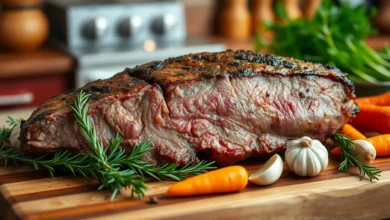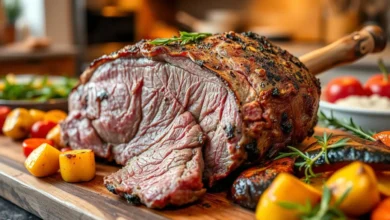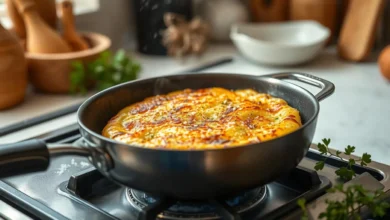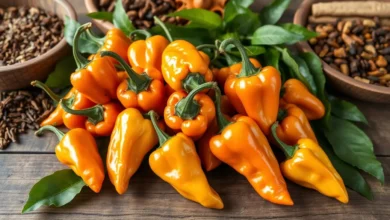Delicious Scotch Bonnet Pepper Recipes You’ll Love
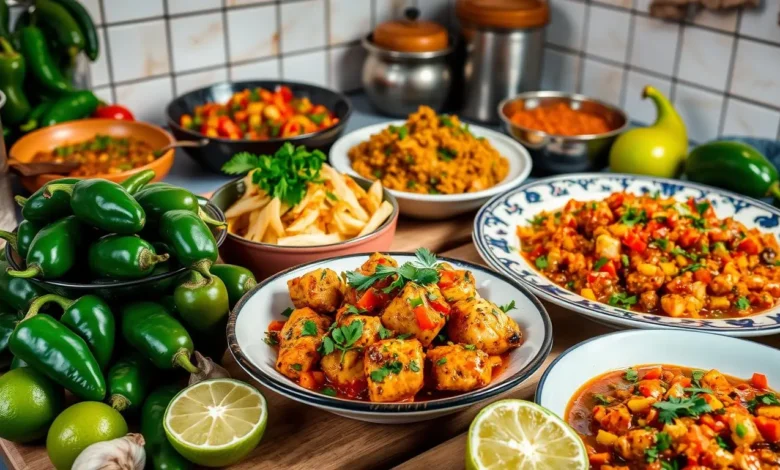
Explore the vibrant flavors of the Caribbean with our collection of Scotch bonnet pepper recipes. This fiery yet fruity pepper is a key ingredient in many island dishes. It adds a unique twist to various recipes, from spicy sauces to flavorful stir-fries and jams.
Understanding Scotch Bonnet Peppers: Heat Level and Flavor Profile
Scotch bonnet peppers are known for their intense heat and unique flavor. They come from the Caribbean and are key in many spicy dishes. Their heat is measured on the Scoville scale, ranging from 100,000 to 350,000 Scoville Heat Units (SHU).
What Makes Scotch Bonnet Peppers Unique
Their unique flavor and heat come from capsaicin, the compound that gives them their fiery kick. Compared to other peppers, Scotch bonnets have a fruity and sweet taste. This makes them stand out.
Health Benefits and Nutritional Value
Scotch bonnet peppers are not just hot; they’re also nutritious. They’re full of vitamin C, vitamin B6, and antioxidants. The capsaicin in them may help fight inflammation and boost metabolism.
Handling and Storage Tips
When using Scotch bonnet peppers, be careful. Their oils can irritate skin and eyes. Wear gloves when handling them. Store them in the fridge for up to a week. For longer storage, freeze or dry them to keep their flavor and heat.
| Pepper Type | Scoville Heat Units (SHU) | Flavor Profile |
|---|---|---|
| Scotch Bonnet | 100,000 – 350,000 | Fruity, sweet, slightly smoky |
| Habanero | 100,000 – 350,000 | Citrusy, floral, slightly fruity |
| Jalapeño | 2,500 – 8,000 | Mild, slightly sweet, green |
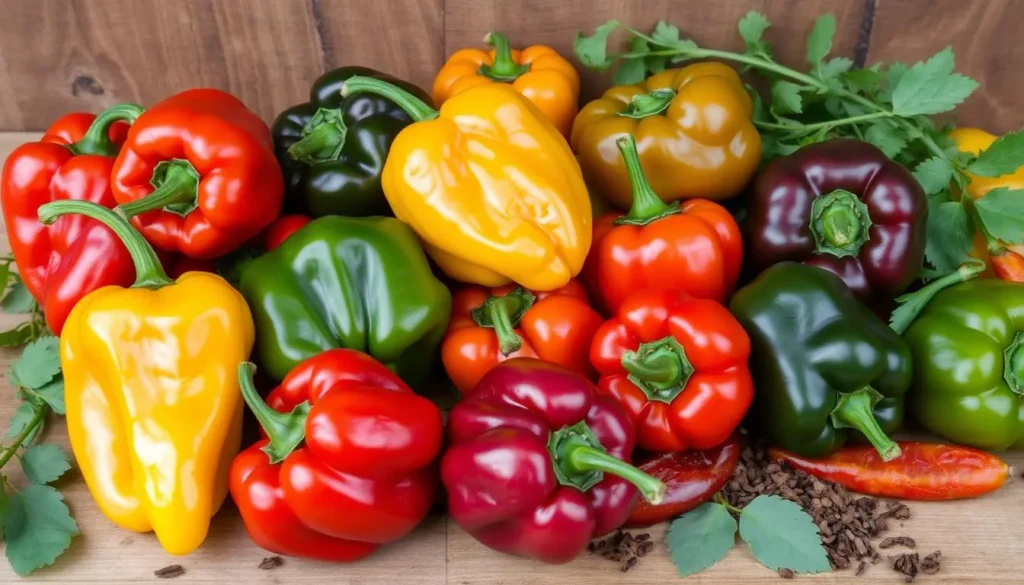
“Scotch bonnet peppers pack a powerful punch, but their unique flavor profile makes them a beloved ingredient in Caribbean cuisine.”
Essential Kitchen Tools and Safety Precautions for Handling Hot Peppers
Working with scorching scotch bonnet peppers in the kitchen needs the right tools and safety steps. Proper preparation and precautions can stop skin irritation, eye exposure, and surprises while cooking.
First, get a pair of pepper gloves. These gloves block the capsaicin-rich oils in peppers, protecting your hands from the heat. Also, wear eye protection like goggles or glasses to avoid pepper spray or splashes when cutting.
Good kitchen ventilation is key when using scotch bonnet peppers. The volatile compounds in these peppers can spread in the air, causing coughing, sneezing, or watery eyes. Make sure your kitchen is well-ventilated by opening windows or using exhaust fans.
Be careful with your cutting technique when preparing peppers. Don’t rub your eyes or face with your hands after handling peppers, as oils can cause irritation. Wash your hands well with soap and water after each step. Use a cutting board just for hot peppers to avoid contamination.
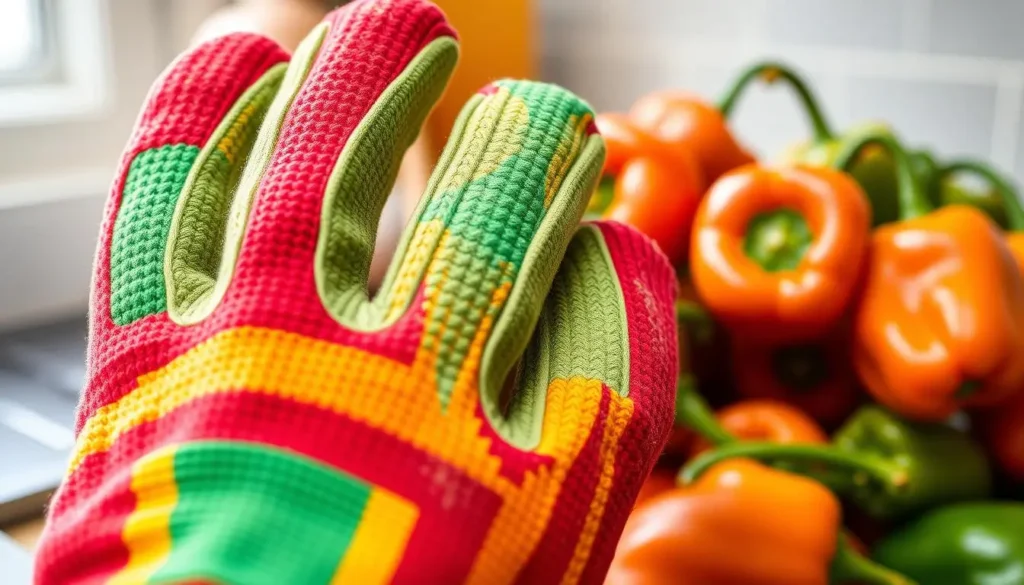
“Handling hot peppers requires extra care and attention to ensure a safe and enjoyable cooking experience.”
By following these simple safety steps and using the right kitchen tools, you can safely explore scotch bonnet peppers. You’ll be able to make tasty, spicy dishes with confidence.
Caribbean-Style Scotch Bonnet Hot Sauce
Try a Caribbean-style scotch bonnet hot sauce for a burst of flavor. It’s a key condiment in island cooking, adding a zesty kick to many dishes. Made from scorching scotch bonnet peppers, it mixes heat, sweetness, and spices for a taste adventure.
Ingredient Variations and Substitutions
Feel free to swap out scotch bonnet peppers for other hot peppers. Habanero, ghost, or mix milder peppers to tweak the heat. Add garlic, onions, vinegar, and spices like allspice or cinnamon to change the flavor.
Storage and Shelf Life Tips
- Keep your hot sauce fresh by storing it in a clean, airtight container in the fridge.
- Fermented hot sauces can last months, while non-fermented ones last 2-3 weeks.
- Check the sauce’s color, smell, and texture. If it’s off, throw it away.
Serving Suggestions
This hot sauce is incredibly versatile. Use it on grilled meats, seafood, or veggies for a spicy kick. Mix it into marinades, dressings, and dips for more flavor. It’s great on sandwiches, tacos, and burritos too. Let your cooking imagination run wild with this Caribbean hot sauce.
If you love homemade hot sauce or fermented flavors, this Caribbean scotch bonnet hot sauce is perfect. Enjoy the heat, sweetness, and Caribbean essence with every delicious bite.
Scotch Bonnet Pepper Recipes for Every Spice Level
Discover a wide range of recipes that highlight the scotch bonnet pepper’s versatility. Whether you’re looking for mild, medium-heat, or extra spicy dishes, we’ve got you covered.
Mild Scotch Bonnet Recipes
Looking for a touch of heat? Try our Scotch Bonnet Guacamole or Scotch Bonnet Chicken Tacos. These recipes offer a perfect mix of flavor and a gentle warmth.
Medium-Heat Dishes
Want a bit more kick? Check out our Scotch Bonnet Shrimp Stir-Fry or Scotch Bonnet Roasted Potatoes. These dishes find the ideal balance between spice and taste.
Extra Spicy Meals
Are you a heat lover? Dive into our Scotch Bonnet Jerk Chicken or Scotch Bonnet Chili Con Carne. These meals will set your taste buds ablaze and leave you wanting more.
Our collection of scotch bonnet pepper recipes caters to all spice levels. Explore the variety of flavors and heat levels to discover your new favorite dish.
Jamaican Jerk Marinade with Scotch Bonnet
Jamaican jerk seasoning is a favorite spice mix. It adds bold and complex flavors to jerk chicken, jerk pork, and more Jamaican cuisine. The Scotch bonnet pepper is key, bringing a fiery kick and unique scent.
Traditional vs. Modern Preparation Methods
Oldly, jerk seasoning was pounded in a mortar and pestle. This made a coarse paste. Now, many use blenders for a smoother marinade.
Best Meats for Jerk Seasoning
- Jerk chicken is a classic, with the bold flavors of the marinade complementing the juicy, tender meat.
- Jerk pork is another popular choice, with the fat in the pork helping to meld the spices and providing a rich, satisfying texture.
- Lamb and beef can also be transformed by the jerk seasoning, adding a unique twist to traditional grilling techniques.
Choosing the right protein is key for perfect Jamaican jerk. Let the marinade soak into the meat. This way, it absorbs the Scotch bonnet peppers, allspice, thyme, and other spices.
Sweet and Spicy Scotch Bonnet Pepper Jam
Try making your own pepper jam with Scotch bonnet peppers for a new taste. This fruit preserves mixes sweet and spicy, adding Caribbean flair to your meals.
Making great Scotch bonnet pepper jam is all about mixing the peppers’ heat with fruit sweetness. This creates a sweet and spicy condiment that excites your taste buds and sparks new recipes.
Versatile Pairing Suggestions
Use this pepper jam on bread or crackers for a tasty snack. It’s also great on grilled meats or fish for a tasty glaze. Try it with soft cheeses or as a dip for savory snacks. The uses for this homemade fruit preserves are endless.
| Pairing Suggestions | Flavor Profile |
|---|---|
| Grilled Meats | The sweetness of the jam complements the savory flavors of grilled meats, creating a harmonious balance. |
| Soft Cheeses | The creamy texture of soft cheeses provides a perfect canvas for the vibrant pepper jam. |
| Crusty Bread | The sweet and spicy condiment adds a delightful contrast to the hearty, crusty bread. |
Explore new flavors with homemade Scotch bonnet pepper jam. Enjoy the sweet and spicy mix of this fruit preserves and discover endless culinary adventures.
Quick and Easy Scotch Bonnet Pepper Infused Dishes
Feeling like you need something spicy fast? We’ve got you covered with these tasty scotch bonnet pepper dishes! From a quick stir-fry to delicious dipping sauces, our recipes will make your meals more exciting.
15-Minute Pepper Stir-Fry
Need a fast and healthy meal? This scotch bonnet stir-fry is ready in 15 minutes. It’s great for when you’re short on time. Thinly sliced chicken or tofu cooks with colorful veggies and a zesty scotch bonnet sauce. It’s full of Caribbean flavors.
Spicy Dipping Sauces
Want to make your snacks more exciting? Try these easy hot sauce recipes with scotch bonnet peppers. You can make a sweet mango-scotch bonnet sauce or a hot habanero dip. These sauces are perfect with fries, veggies, or empanadas.
Ready to add some heat to your meals? These scotch bonnet pepper dishes are quick and easy. Whether you want a fast stir-fry or a tasty dip, these recipes will hit the spot.
Tips for Growing Your Own Scotch Bonnet Peppers
If you love the bold flavor and heat of scotch bonnet peppers, you can grow them at home. You don’t need a big backyard to do it. Growing scotch bonnets can be fun and rewarding, whether you have a lot of space or just a few containers.
Soil and Sunlight Requirements
Scotch bonnet peppers need good soil and lots of sunlight. Make your soil better by adding compost or aged manure. They also need at least 6 hours of direct sunlight every day.
Watering and Fertilizing
Water your scotch bonnet plants regularly but not too much. Check the soil when it’s dry about an inch down. Use a balanced fertilizer every 4-6 weeks to help them grow strong.
Container Gardening
Scotch bonnet peppers can also grow in containers. Pick a pot that’s at least 12 inches deep and wide. Make sure it has holes for water to drain. Use a mix that drains well and water and fertilize like you would for plants in the ground.
Pest Control and Harvesting
Watch out for pests like aphids and spider mites. Use natural ways to control them, like picking them off or using insecticidal soap. Pick your peppers when they’re the right color and size, usually 2-3 inches long. Cut them off with clean scissors or pruners.
By following these tips, you can grow lots of scotch bonnet peppers. Use them in your favorite Caribbean dishes and spicy sauces. Enjoy the flavors and the pride of growing your own peppers!
| Pepper Gardening Tip | Description |
|---|---|
| Soil and Sunlight Requirements | Scotch bonnet peppers thrive in well-draining, nutrient-rich soil and require at least 6 hours of direct sunlight per day. |
| Watering and Fertilizing | Water the soil when the top inch becomes dry, and supplement plants with a balanced, slow-release fertilizer every 4-6 weeks. |
| Container Gardening | Scotch bonnet peppers can be grown in containers at least 12 inches deep and wide, using a well-draining potting mix. |
| Pest Control and Harvesting | Manage common pests using organic methods, and harvest peppers when they reach the desired color and size. |
Conclusion
The Scotch Bonnet pepper is a true culinary gem. It offers a unique mix of heat and flavor. This can make any dish better.
These peppers can turn your cooking into something special. They can make your dishes zesty and spicy. They’re perfect for those who love spicy food.
Exploring Scotch Bonnet pepper recipes opens up new possibilities in the kitchen. You can try jerk marinades or make sweet and spicy jams. Growing your own peppers is also an option.
As you keep exploring, don’t be afraid to try new things. Let the bold flavors of the Scotch Bonnet pepper inspire you. Create your own dishes that show off the Caribbean’s essence.
So, go ahead and enjoy the fiery delights that await you. Bon appétit!
FAQ
What makes scotch bonnet peppers unique?
Scotch bonnet peppers have a fruity-sweet taste and are very hot. They are key in Caribbean cooking, adding a spicy flavor to dishes.
What are the health benefits of scotch bonnet peppers?
These peppers are full of vitamins and antioxidants. They have lots of Vitamin C, B6, and A. They also have capsaicin, which might help with inflammation and boost metabolism.
How should I handle and store scotch bonnet peppers?
Wear gloves when handling these peppers to avoid eye and face irritation. Keep them in a sealed container in the fridge to stay fresh. They last about a week when stored right.
What are some essential kitchen tools for working with scotch bonnet peppers?
You’ll need pepper gloves, a sharp knife, and a cutting board. A well-ventilated kitchen is also important. Eye protection and a blender can help with big batches.
How long does homemade scotch bonnet hot sauce last?
Homemade hot sauce lasts 3-6 months in the fridge. The fermentation process helps it last longer. For the best taste, use it within 2-3 months.
What are some creative ways to use scotch bonnet pepper jam?
Use scotch bonnet pepper jam as a glaze for meats, in salad dressings, or on toast. It’s also great as a dipping sauce for appetizers.
What are the best meats to use with a Jamaican jerk marinade?
Chicken and pork are the best for Jamaican jerk. The flavors match well with these meats. You can also use it on beef, fish, or tofu for a veggie option.
How can I grow my own scotch bonnet peppers at home?
Grow them in warm, sunny spots with good drainage. Use garden beds or big containers. Water often and support the plant as peppers grow. Pick them when ripe for the best taste and heat.
